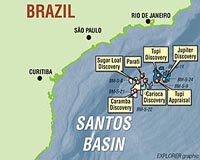 |
Miami (AFP) Oct 1, 2010 Traces of oil from a ruptured BP well in the Gulf of Mexico have been found at a depth of 1,000 meters (3,200 feet) and up to 500 kilometers (300 miles) from the spill site, according to a new analysis. A team of scientists aboard the Greenpeace ship Arctic Sunrise reported results Thursday from 10 days of sampling around areas affected by the worst oil spill in history. "From the measurements we've taken, we see clear signs of oxygen deficiency on a large transect starting at the Macondo wellhead, all the way 300 miles to the west," said Rainer Amon, a Texas A&M scientist who participated in the research. "How much of oil and gas components are still in the water is something that we need to now investigate in the laboratory." The expedition had four points plotted to the west of the well to investigate what is considered the main path of oil after the April accident that led to a massive release of crude oil. They concluded that the dissolved oxygen level was not as low as scientists would have expected if a greater proportion of oil and gas had dissolved in the water. This suggests that oil has not "disappeared" some have suggested, and that as much as three to four million barrels of crude from the disaster have still not been accounted for. "Despite everything that BP and the government would like us to think, the truth is, the oil spill's impact is not over," said Greenpeace US research director Kert Davies. "Scientists know better, fishermen know better, the people of the Gulf and certainly the clean up crews endlessly picking up tar balls know better. The government and BP need to be honest with everyone about the extent of the damage." The researchers conducted a parallel study of sea lift, and obtained samples of sediment on the ocean floor at a depth of 1,300 meters (4,20 feet), eight kilometers (five miles) from the disaster site. Some of the samples contained visible amounts of oil with a strong smell, said Greenpeace. The samples have been sent to an independent laboratory for study and to determine the presence of chemical dispersants. In October, other scientists will join the Greenpeace expedition, which used a submersible to dive to the ocean floor to study the effects of oil disaster in coral reef habitats and marine communities. "What we want to do is to come up with a mass balance of how much oil was put in the water column, the sediment surface," Amon said. "When we've analyzed all the samples we've collected for our work and that of our colleagues, we hope to come up with a pretty good estimate of how much of the oil and gas was put into the system. Hopefully we can then come up with good ideas of where that missing oil and gas has gone." Some 205 million gallons of oil flowed into the Gulf after the April 20 explosion aboard the BP-leased Deepwater Horizon oil rig, impacting the crucial fishing and tourism industries and destroying hundreds of miles of the region's fragile coastal ecosystems.
Share This Article With Planet Earth
Related Links Powering The World in the 21st Century at Energy-Daily.com
 Repsol, Sinopec in deal to tap vast Brazilian oilfields
Repsol, Sinopec in deal to tap vast Brazilian oilfieldsMadrid (AFP) Oct 1, 2010 Spanish energy giant Repsol Friday announced a 7.1-billion-dollar alliance with China's Sinopec, a major international player, to help develop Brazil's massive offshore oil reserves. Sinopec, which as part of China's drive to secure energy supplies for its booming economy already has Brazilian interests, will take a 40-percent stake in Repsol's Brazil affiliate. The deal will make Repsol ... read more |
|
| The content herein, unless otherwise known to be public domain, are Copyright 1995-2010 - SpaceDaily. AFP and UPI Wire Stories are copyright Agence France-Presse and United Press International. ESA Portal Reports are copyright European Space Agency. All NASA sourced material is public domain. Additional copyrights may apply in whole or part to other bona fide parties. Advertising does not imply endorsement,agreement or approval of any opinions, statements or information provided by SpaceDaily on any Web page published or hosted by SpaceDaily. Privacy Statement |